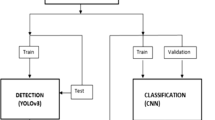Abstract
Due to drastic changes in the field of technology and computing power for the last decade, it has become very easy to implement the convolutional neural networks for the classification and detection of objects from the large volume of images. Nowadays, the various deep networks with hundreds of layers are developed and implemented by the researchers for the classification of images and object detection inside the images. The Faster region-based convolutional neural network (R-CNN) is a widely used state-of-the-art approach that belongs to R-CNN techniques that were first time developed and used in 2015. Different R-CNN object detection approaches are developed and implemented by the researchers. Three approaches are developed and implemented on different platforms, and these approaches are R-CNN, fast R-CNN, and faster R-CNN. The efficiency and accuracy of the approaches are tested for various object detections inside the different images. Algorithms based on region proposals are used in R-CNN approaches to generate the bounding boxes or the actual location of the objects inside the images. The ground labels are generated through image labeling approaches. These ground truth labels are stored in a file. The features are extracted by pre-trained deep networks or the convolutional neural networks using the ground truth labeled images. The classification layer of the convolutional neural networks predicts the class of the object to which it belongs. The regression layer is used to create the relevant coordinates of the bounding boxes accurately. In this research paper, the faster R-CNN approach with retrained deep networks is used for the detection of pituitary tumor. The tumor detection performance of the detectors trained with three pre-trained deep networks is compared in the proposed approach of tumor detection. Three pre-trained deep networks such as Googlenet, Resnet18, and Resnet50 are used to train the tumor detector with ground truth labeled images.
Access this chapter
Tax calculation will be finalised at checkout
Purchases are for personal use only
Similar content being viewed by others
References
LeCun, Y., Bengio, Y., Hinton, G.: Deep learning. Nature 521, 436–444 (2015)
Girshick, R.: Fast R-CNN. In: Proceedings of the 2015 IEEE International Conference on Computer Vision. Santiago, Chile, Dec. 2015, pp. 1440–1448
Vijayakumar, T.: Neural network analysis for tumor investigation and cancer prediction. J. Electron 1(02), 89–98 (2019)
Faster R-CNN: Down the rabbit hole of modern object detection, available [online]. https://tryolabs.com/blog/2018/01/18/faster-r-cnn-down-the-rabbit-hole-of-modern-object-detection
The Complete Beginner’s Guide to Deep Learning: Convolutional Neural Networks and Image Classification, available [online]. https://towardsdatascience.com/wtf-is-image-classification-8e78a8235acb
Pituitary Tumors available [online]. https://www.mayoclinic.org/diseases-conditions/pituitary-tumors/symptoms-causes/syc-20350548
Ari, A., Hanbay, D.: Deep learning based brain tumor classification and detection system. Turk J Electr Eng Comp Sci 26, 2275–2286 (2018). https://doi.org/10.3906/elk-1801-8
Fast R-CNN for object detection, available [online]. https://towardsdatascience.com/fast-r-cnn-for-object-detection-a-technical-summary.
Pituitary Tumors, available [online]. https://www.aans.org/en/Patients/Neurosurgical-Conditions-and-Treatments/Pituitary-Gland-and-Pituitary-Tumors
Introduction to basic object detection algorithms, available [online]. https://heartbeat.fritz.ai/introduction-to-basic-object-detection-algorithms-b77295a95a63
Hashemzehi R, et al.: Detection of brain tumors from MRI images base on deep learning using hybrid model CNN and NADE. Biocybern Biomed Eng (2020). https://doi.org/10.1016/j.bbe.2020.06.001
Krizhevsky, A., Sutskever, I., Hinton, G.: ImageNet classification with deep convolutional neural networks. In: Proceedings of the Advances in Neural Information Processing System, vol. 25, 1090–1098 (2012)
Yamashita, R., Nishio, M., Do, R.K.G., et al.: Convolutional neural networks: an overview and application in radiology. Insights Imaging 9, 611–629 (2018). https://doi.org/10.1007/s13244-018-0639-9
He, K., Zhang, X., Ren, S., Sun, J.: Deep residual learning for image recognition. In: Proceedings of the IEEE Conference on Computer Vision and Pattern Recognition, pp. 770–778 (2016)
Key Statistics About Pituitary Tumors, available [online]. https://www.cancer.org/cancer/pituitary-tumors/about/key-statistics.html
Cheng, J.: Brain tumor dataset. Figshare. Dataset. https://doi.org/10.6084/m9.figshare.1512427.v5 (2017)
Precision and recall, available, [online]. https://deepai.org/machine-learning-glossary-and-terms/precision-and-recall
Girshick, R., Donahue, J., Darrell, T., Malik, J.: Rich feature hierarchies for accurate object detection and semantic segmentation. In: Proceedings of the 2014 IEEE Conference on Computer Vision and Pattern Recognition. Columbus, OH, June 2014, pp. 580–587
He, K., et al.: Spatial pyramid pooling in deep convolutional networks for visual recognition. Lecture Notes in Computer Science
Ren, S., He, K., Gershick, R., Sun, J.: Faster R-CNN: Towards real-time object detection with region proposal networks. IEEE Trans. Pattern Anal. Mach. Intell. 39(6), 1137–1149 (2017)
MATLAB R2020a, The MathWorks, Inc., Natick, Massachusetts, United States
Author information
Authors and Affiliations
Corresponding author
Editor information
Editors and Affiliations
Rights and permissions
Copyright information
© 2021 The Editor(s) (if applicable) and The Author(s), under exclusive license to Springer Nature Singapore Pte Ltd.
About this paper
Cite this paper
Ram, S., Gupta, A. (2021). Pre-trained Deep Networks for Faster Region-Based CNN Model for Pituitary Tumor Detection. In: Shakya, S., Balas, V.E., Haoxiang, W., Baig, Z. (eds) Proceedings of International Conference on Sustainable Expert Systems. Lecture Notes in Networks and Systems, vol 176. Springer, Singapore. https://doi.org/10.1007/978-981-33-4355-9_36
Download citation
DOI: https://doi.org/10.1007/978-981-33-4355-9_36
Published:
Publisher Name: Springer, Singapore
Print ISBN: 978-981-33-4354-2
Online ISBN: 978-981-33-4355-9
eBook Packages: EngineeringEngineering (R0)




